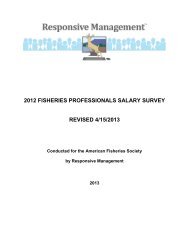Conservation Status of Crayfish Species Paddlefish Conservation ...
Conservation Status of Crayfish Species Paddlefish Conservation ...
Conservation Status of Crayfish Species Paddlefish Conservation ...
You also want an ePaper? Increase the reach of your titles
YUMPU automatically turns print PDFs into web optimized ePapers that Google loves.
lution <strong>of</strong> the past 10 years has spawned an<br />
equally disconcerting vector. <strong>Conservation</strong><br />
biologists have for years warned <strong>of</strong> the risk<br />
posed from the release/escape <strong>of</strong> pets. From<br />
monk parakeets in Chicago (Kleen et al.<br />
2004) to burmese pythons in the Florida<br />
Everglades (Mcgrath 2005), established<br />
populations <strong>of</strong> organisms kept as pets have<br />
become an unwelcome component <strong>of</strong> the<br />
North American fauna. Currently over<br />
a half-dozen Internet businesses (www.<br />
google.com search conducted 03/23/07)<br />
and numerous individuals on the Internet<br />
auction site eBay® (www.ebay.com) <strong>of</strong>fer<br />
for sale dozens <strong>of</strong> live crayfish species from<br />
North America and around the world.<br />
While the aquarium pet trade has been<br />
around for more than half a century, crayfishes<br />
are a recent arrival to the aquarium<br />
marketplace. The ease <strong>of</strong> 24-hour shopping<br />
and overnight delivery to anywhere in the<br />
world facilitated by the Internet has dramatically<br />
increased the potential for accidental<br />
introductions <strong>of</strong> crayfishes.<br />
While no known cases <strong>of</strong> overexploitation<br />
<strong>of</strong> crayfish have been documented in<br />
North America, it has been cited as a contributing<br />
factor in the decline <strong>of</strong> at least one<br />
Australian crayfish species. The Tasmanian<br />
crayfish (Astacopsis gouldi) can reach sizes<br />
in excess <strong>of</strong> 0.8 meters in length (> 5 kg<br />
in weight), and its meat is valued by local<br />
inhabitants. The species has experienced<br />
local extirpations and population declines<br />
throughout a significant portion <strong>of</strong> its range,<br />
and over-harvesting has been implicated as<br />
a contributing factor (Horwitz 1994). We<br />
acknowledge that overexploitation is not<br />
an imminent threat to United States and<br />
Canadian crayfish populations; however,<br />
we believe that it is prudent to acknowledge<br />
this potential threat and be proactive<br />
in future crayfish fishery decisions.<br />
Members <strong>of</strong> the genus Fallicambarus, such as<br />
the burrowing bog crayfish (F. burrisi) here, are<br />
all burrowing species.<br />
photo by G. Schuster.<br />
The above-listed threats are not unique<br />
to crayfishes; however, they are compounded<br />
by a single overarching factor—limited natural<br />
ranges (Taylor et al. 1996). <strong>Crayfish</strong>es<br />
show a level <strong>of</strong> endemism not seen in other<br />
aquatic groups. Approximately 43% <strong>of</strong> the<br />
U.S. crayfish fauna is distributed entirely<br />
within one state’s political boundaries, compared<br />
to 16% for freshwater fishes and 15%<br />
for unionid mussels (Lodge et al. 2000). In<br />
their first conservation assessment, Taylor et<br />
al. (1996) documented 11 crayfish species<br />
known from single localities and another<br />
20 known from 5 or fewer localities. While<br />
taxa with restricted natural ranges are particularly<br />
vulnerable to habitat destruction<br />
or degradation, the known displacement<br />
abilities <strong>of</strong> nonindigenous crayfishes when<br />
coupled with a high level <strong>of</strong> endemism represent<br />
a threat <strong>of</strong> unequalled severity.<br />
prOgreSS and ChangeS<br />
The conservation status <strong>of</strong> 30 taxa has<br />
changed since the previous assessment<br />
(Taylor et al. 1996). These changes have<br />
been facilitated by an increased awareness<br />
<strong>of</strong> crayfishes (Butler et al. 2003) and a subsequent<br />
increase in field efforts undertaken<br />
by federal (e.g.; Simon and Thoma 2003),<br />
state (e.g.; Thoma and Jezerinac 2000;<br />
Westh<strong>of</strong>f et al. 2006), and academic (e.g.;<br />
Ratcliffe and deVries 2004; Taylor and<br />
Schuster 2004) personnel. These efforts<br />
have provided new distributional records<br />
that led to downgrading 25 taxa by at least<br />
one conservation category. Simultaneously,<br />
these efforts documented the introduction<br />
<strong>of</strong> nonindigenous species into the ranges <strong>of</strong><br />
narrow endemics (Flinders and Magoulick<br />
2005) and the subsequent reductions in<br />
range sizes, leading to the upgrading <strong>of</strong> four<br />
taxa. Promising signs <strong>of</strong> increased awareness<br />
are the proposed changes in bait regu-<br />
due to their restricted ranges, specialized<br />
habitats, and the development <strong>of</strong> groundwater<br />
recharge areas, many obligate cave dwelling<br />
crayfish species such as the orlando cave<br />
crayfish (Procambarus acherontis) are listed as<br />
endangered.<br />
photo by d. McShaffrey.<br />
lations by several states in an attempt to<br />
thwart the spread <strong>of</strong> nonindigenous crayfishes,<br />
as well as an increase in the number<br />
<strong>of</strong> crayfishes listed by state agencies as<br />
endangered, threatened, or vulnerable/special<br />
concern. Virginia now bans the sale <strong>of</strong><br />
crayfish as bait while Missouri has followed<br />
the lead <strong>of</strong> other states and recently created<br />
a prohibited species list for use by bait dealers<br />
which includes several nonindigenous<br />
crayfishes (B. Watson, VA dept. game and<br />
Inland Fisheries, pers. com.; B. diStefano,<br />
pers. com.). Since 1996 at least two new<br />
states, Pennsylvania and North Carolina,<br />
have added the rusty crayfish to their lists <strong>of</strong><br />
banned species (www.fish.state.pa.us/newsreleases/2005/rusty_cray.htm;<br />
NCWRC<br />
2006). North Carolina also banned the<br />
transport, purchase, and possession <strong>of</strong> the<br />
nonindigenous virile crayfish (O. virilis).<br />
While the level <strong>of</strong> protection afforded to<br />
species listed at the state level ranges from<br />
bans on taking to token lists for future<br />
research efforts, it is noteworthy that the<br />
number <strong>of</strong> species listed at some level has<br />
increased from 47 to 66 since 1996. Finally,<br />
seven states (Arkansas, Missouri, New<br />
Mexico, North Carolina, South Carolina,<br />
Tennessee, Virginia) now have at least one<br />
field biologist in their respective natural<br />
resource agencies whose position requires<br />
them, at least on a part time basis, to monitor<br />
and assess crayfish populations. Taken<br />
together, these regulatory actions and field<br />
efforts can be interpreted as nothing less<br />
than progress in the domain <strong>of</strong> crayfish conservation.<br />
However, the majority <strong>of</strong> states<br />
with highly diverse crayfish faunas and high<br />
levels <strong>of</strong> endemism lack any protective<br />
measures and adequate funding structures<br />
to ascertain the statuses <strong>of</strong> their respective<br />
faunas.<br />
While little research is being conducted<br />
in Canada at present, its crayfish fauna was<br />
Meek’s crayfish (Orconectes meeki meeki)<br />
is a common inhabitant <strong>of</strong> ozark streams in<br />
Missouri and Arkansas.<br />
photo by c. Taylor.<br />
Fisheries • vol 32 no 8 • august 2007 • www.fisheries.org 375







